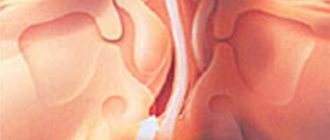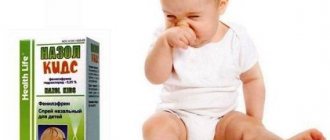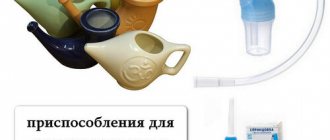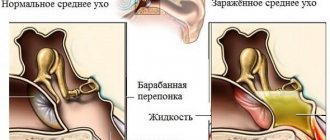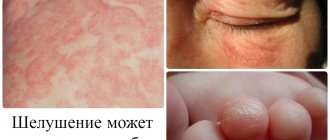You can treat nasal congestion at home using pharmaceutical drugs or folk remedies. To do this, you need to understand the cause of the symptom: it can be caused by allergic rhinitis, colds, or mechanical irritation of the mucous membrane. Difficulty breathing is often worse at night, but may persist during the day. Treatment of a runny nose and nasal congestion should be started immediately - an advanced infection can lead to dangerous complications, including chronic bronchitis and pneumonia.
What is the peculiarity of the condition
The condition of nasal congestion without a runny nose is not very pleasant.
Due to constant swelling of the mucous membrane, breathing is impaired. This symptom leads to serious problems. This manifests itself in the form of decreased performance, concentration, fatigue, and sleep disturbances. This happens when the brain is starved of oxygen, which is caused by insufficient ventilation of the lungs. Breathing through the mouth does not improve the situation, since it does not provide the necessary pressure in the alveoli of the lungs, and oxygen does not enter the blood well.
https://www.youtube.com/watch?v=
Nasal congestion without a runny nose in adults is accompanied by the same symptoms as rhinitis, excluding mucous discharge. With this condition, the following is likely to occur:
- dryness, burning, itching in the nose;
- constant sneezing;
- headaches, dizziness;
- lacrimation;
- discomfort in the soft tissues of the face.
Constantly stuffy nose, but no runny nose - what doctors say
Very often, intervention will be absolutely useless, since such a phenomenon as nasal congestion is caused by physiological processes. If such a symptom is prolonged, then you should seek help from a doctor. He will find out the exact cause of the origin of this disease and prescribe proper treatment.
Popular site article: Causes of bloating and gas formation. How to treat the stomach
Doctors who treat nasal diseases are otolaryngologists. They know the reasons why such trouble can occur.
Nasal congestion without runny nose. You will find the causes and treatment in adults and children further in the article.
Experts name several of them:
- response to drug treatment;
- the room is not ventilated, and the temperature in it is maintained high;
- the body experienced severe hypothermia;
- concomitant acute respiratory viral infections and acute respiratory infections;
- the presence of polyps in the nose;
- the presence of adenoids, which often provoke colds;
- alcohol and smoking.
For such reasons, there is nothing to worry about, you just need to remove one of these factors. There is nasal congestion, which may indicate the severity of the disease. At first, congestion is observed only in one nostril, then it moves to the second.
Experts call this condition rhinitis:
- air tickles inside the nasal passages;
- frequent sneezing;
- a clear liquid appears.
Forms of congestion
The causes of nasal congestion without a runny nose may lie in inflammation of the tissues of the nasopharynx or stagnation of mucus inside the nasal cavity. Inflammatory reactions in the respiratory tract can be caused by infectious agents (microbes, fungal spores, viruses), allergens or injuries. Subsequent tissue swelling entails a narrowing of the internal diameter of the airways. The accumulation of muconasal secretions in the respiratory tract leads to clogged nasal canals and, accordingly, difficulty breathing.
In otolaryngology, there are several forms of nasal congestion without a runny nose, namely:
- morning - the feeling of congestion worsens exclusively in the morning immediately after waking up, which is most often associated with stagnation of mucus in the respiratory tract;
- night - it becomes difficult to breathe only when a person takes a horizontal position;
- chronic - the nose is constantly clogged, so patients try to eliminate the manifestations of the disease with vasoconstrictor drops;
- periodic - difficulty in nasal breathing is not always observed, but only at certain limited periods of time.
Nasal congestion without snot can be a manifestation of a serious disease, so if a symptom occurs, it is recommended to undergo a rhinoscopic examination by an ENT doctor.
The causes of nasal congestion without a runny nose in adults can be different. In any case, this condition causes discomfort. Several forms of the disease should also be taken into account:
- Constant. Chronic nasal congestion without a runny nose is the most unpleasant, since even with regular nose blowing there is no relief. Symptoms usually last for several months until the person sees a doctor. Provoking factors include bone septal defect, polyps, diseases of the endocrine system, and vasomotor rhinitis. Treatment of persistent nasal congestion without a runny nose should be performed under the supervision of a physician.
- Frequent. The regularity of nasal congestion depends on the provoking factor. The exacerbation is replaced by phases of stable remission, so the sick person does not see a doctor for a long time.
- Night. This condition causes severe discomfort. The causes of nasal congestion without a runny nose at night are physiological and pathological. Appears with sluggish inflammation of the nasopharynx.
- Morning. If congestion occurs in the morning, you should undergo an examination to identify the causes of this condition. Provoking factors can be different - from allergies to bedding or down pillows to sinusitis.
Since a long-term condition is considered a symptom of the presence of a chronic pathology in the body, a person should consult a doctor as soon as possible. Timely treatment can quickly eliminate discomfort.
Causes of nasal congestion without runny nose in adults
Nasal congestion without a runny nose is common in many adults and occurs for a number of other reasons than those previously discussed. Nasal congestion must be treated, as the infection can spread to the throat and even ears.
Don't miss useful advice from doctors on: How to treat itchy body skin and why does it appear? Main reasons.
Many doctors believe that the nose is blocked due to a number of unfavorable environmental conditions: there are many impurities of dust, gas, gasoline and other harmful substances in the air.
This is a huge load for the nose; it cannot cope with it. And an allergic reaction to tobacco smoke and perfume products can occur, which can cause blockage of the nasal passages.
Sometimes improper treatment can lead to nasal congestion without a runny nose:
- The nose is constantly blocked in the chronic form, resulting in difficulty breathing and oxygen deficiency.
- Congestion can be periodic; this is considered a common form.
- Sometimes it becomes difficult for a person to breathe only at night - this is the nocturnal variety. It is worth ventilating the room more often before going to bed.
- Difficulty breathing is observed immediately in the morning.
You can eradicate any form of nasal congestion in the following ways:
- Eliminate dry air.
- Get rid of factors that influence dehydration of the nasal mucosa (presence of dust, cigarette smoke, alcohol).
- Poor diet (too much sugar).
- Uncontrolled use of drugs.
- Consequences of colds.
Note! This pathology is not the norm; if the nose is constantly stuffy, it is worth checking the condition of the body as a whole to exclude diseases of the internal organs.
Exogenous causes
Difficulty in nasal breathing is most often associated with the negative effects of exogenous factors. Drying of the mucous membranes leads to irritation, which subsequently leads to inflammation and swelling of the nasal passages. If you have a stuffy nose without a runny nose, it is very important to identify and eliminate the cause of the unpleasant phenomenon in a timely manner. Delayed and inadequate treatment of inflammation is fraught with infectious diseases and benign tumors in the nasopharynx.
Unfavorable environmental conditions are one of the key causes of impaired nasal breathing. The nasopharynx acts as a filter in the body, purifying the air from harmful impurities, infectious agents, allergens, etc. An increase in the amount of irritating substances in the atmosphere inevitably leads to an increase in the load on the respiratory system. As a result, swelling occurs in the soft tissues of the nasal cavity, making it difficult to breathe through the nose.
According to statistics, over the past 50 years the concentration of harmful substances in the environment has increased by 35%. Exhaust gases and emissions from industrial enterprises create excessive stress on the mucous membranes of the ENT organs. According to allergists, this is precisely the reason for the sensitization of the human body and the increase in the number of patients suffering from hay fever, contact dermatitis and other types of allergic diseases.
If your nose is stuffy without manifestations of rhinitis for 10-14 days, most likely the cause lies in low-grade inflammation of the nasopharynx and paranasal sinuses.
A clogged nose without snot can be the result of a mechanical injury, as well as a thermal or chemical burn. Damage to the mucous membrane leads to inflammation of the ciliated epithelium, which lines the inner surface of the airways. Violation of the integrity of tissues in the nasal cavity can be caused by
- steam inhalations;
- volatile chemicals;
- fumes from household chemicals;
- nasal injuries.
Severe congestion is a key cause of impaired gas exchange in tissues and the development of non-infectious pathologies.
In cases where the nose does not breathe, but there is no rhinitis, it is necessary to use anti-edematous and wound-healing drugs. If the injury was caused by a mild burn, the ENT doctor will recommend rinsing the nasal cavity with antiseptic and isotonic solutions.
Dehydration
Fluid deficiency in the mucous membranes leads to disruption of the secretory function of the glands that secrete muconasal secretions. Insufficient hydration of the nasopharynx is fraught with irritation of the mucous membrane and its swelling. If your nose is stuffy but there is no snot, there may be several reasons for this:
- violation of the drinking regime;
- insufficient air humidification;
- abuse of carbonated drinks;
- inhalation of dusty air.
If the snot does not flow, this does not mean that there is no inflammation in the respiratory tract. Stagnation of mucus in the nasal cavity occurs due to obstruction of the airways. In adults, “dry congestion” is most often associated with working in hazardous industries. As a rule, the problem occurs among people working in the cement and textile industries, in chalk quarries and factories for the production of paints and varnishes.
Causes of nasal congestion without runny nose in children
In children, any disease is much more acute, and complications often arise. To avoid this, it is necessary to understand the reasons that cause difficulty in children's breathing.
Read the site's popular article: Quick ways to get rid of heartburn. Medicines (drugs) for heartburn. How to treat at home.
Infants have very narrow nasal passages, the amount of air entering through the nose is small. Therefore, the baby connects the mouth to the breathing process, and there is a feeling that the baby’s nose is stuffy. The main factor influencing nasal congestion is dry mucus in the nasal passages, which clogs the breathing passages.
The consequences of this could be:
- microcracks;
- edema;
- inflammation.
There are other reasons:
- Consequences of injury.
- Physiological features of the nasal septum.
- ARVI, accompanied by congestion and inflammation of the nasal cavity.
- Foreign bodies in the nasopharynx.
- Development of polyps.
- Inflammation of the adenoids and oropharynx.
- Allergies (seasonal and chronic).
- Consequences of taking medications.
Pathological factors
The causes of nasal congestion without a runny nose in adults can be different. Moreover, this is not always associated with a dangerous chronic illness. Often the problem is due to physiological reasons:
- Lack of air humidity in the room. It is usually dry in winter, when heating devices are actively working. Then the relative humidity can drop to 35-40%, which negatively affects the nasal epithelium. The mucous membrane will be dry and thin, which leads to the action of protective mechanisms - mucus is formed by goblet cells.
- Poor nutrition. When you eat a lot of fatty foods, starchy foods, and sweets, especially if you are overweight, your blood sugar rises. The cause of nasal congestion without a runny nose in adults may be a hormonal imbalance.
- Side effects from drugs. If you are undergoing long-term treatment for a chronic illness, for which nasal medications are used, a side effect is dry nasal congestion. Often this condition goes away on its own when therapy is completed.
- Poor circulation in the head and neck. The problem arises when a person rarely goes out into fresh air, eats poorly, smokes and drinks alcohol. To improve the condition, you need to make lifestyle changes. You should be in the fresh air more often, eliminate bad habits, and start playing sports.
Congestion that suddenly appears in a healthy person occurs from hypothermia. After frost, you may feel an accumulation of mucus in the nose, which is associated with a sharp narrowing of blood vessels. This condition can persist overnight, and in the morning the discomfort disappears.
The causes of constant nasal congestion without a runny nose can be pathological. They are often chronic in nature, which leads to long-term discomfort.
Immune cells produce the thymus (thymus gland), and their movement throughout the body occurs with the blood and lymph flow. If bacteria or viruses multiply in the nose, the response of the defense system will be to dilate blood vessels, which increases blood flow to inflammation and immune cells. This is how the fight against pathogenic microorganisms occurs.
There are many capillaries in the nasal mucosa. Due to swelling, the mucous membrane will become thicker, therefore blocking the nasal canal - partially or completely. This is why nasal congestion occurs. Such protection is typical for the initial stage of the disease, when mucus has not appeared and the immune response has been launched.
In the chronic course of the disease, this cycle is repeated again and again, since it is not always possible to get rid of pathogenic microorganisms completely with your immunity. After the weakening of the protective forces, the bacteria begin to actively multiply again.
Chronic nasal congestion without runny nose: treatment
If the nasal mucosa is swollen and inflamed, congestion occurs. When this is already chronic, the patient’s well-being worsens because it is impossible to breathe through the nose.
There are a number of contributing factors:
- Performance decreases.
- A headache appears.
- There is a problem with sleep.
For chronic disease, the following medications are recommended:
- Drops prepared from medicinal plants.
- Inhalations using medicinal herbs or medications.
- Nasal rinsing.
The well-known plantain plant is an excellent helper for chronic nasal congestion. Grind the leaves of the plant. Dial 1 tbsp. l. prepared herbs, pour 1 tbsp. boiling water, cool, strain. Drip the resulting solution several times a day, 3 drops into each nostril. Plantain can be used if it turns out that the cause of nasal congestion lies in allergies.
For inhalation, decoctions of the following herbs are used:
- calendula;
- chamomile;
- wild rosemary;
- thyme;
- coltsfoot;
- raspberry leaves.
But it is better to carry out all inhalation procedures using a special device - a nebulizer, as it is absolutely safe and effective.
Note! Chronic congestion can be treated only with folk remedies, so as not to once again poison the body with drugs containing various chemical components.
Infectious diseases
Why doesn't the nose breathe and there is no snot? Malfunctions in the upper respiratory tract are in most cases associated with an infectious lesion of the nasopharynx. Rhinitis during a cold appears only on the 3rd day after infection of the ENT organs. Viruses and bacteria penetrating into the nasal cavity provoke inflammation and swelling of the tissues, which causes nasal congestion.
Sinusitis
If inflammation occurs in one or several paranasal sinuses (sinuses), they speak of the development of sinusitis. The mucous membrane of the paranasal sinuses practically does not contain exocrine glands, therefore, even with infectious inflammation of the tissues, almost no mucus is formed in them. If the sinuses are infected, the following symptoms will indicate the development of pathology:
- discomfort in the bridge of the nose and eyebrows;
- nasal voice;
- fast fatiguability;
- constant sneezing;
- increase in body temperature.
Inflammation in the paranasal sinuses is most often caused by pathogenic bacteria, so local and systemic antibiotics are used to treat the pathology.
When there is no runny nose, but the nose is stuffy for 2-3 weeks, this indicates low-grade inflammation of the respiratory tract. If pathological processes in the airways are not stopped in time, this can subsequently lead to the development of meningitis, peritonsillar abscess or sepsis.
Nasopharyngitis
Chronic nasal congestion without a runny nose often accompanies the development of bacterial nasopharyngitis. Low-grade inflammation may be associated with:
- frequent hypothermia;
- deformations of the nasal septum;
- smoking;
- inhalation of polluted air.
In an adult, a chronic form of nasopharyngitis can develop against the background of inadequate treatment of rhinorrhea and bacterial rhinitis. As the disease progresses, patients may complain of headaches, sore throat, dry nasal cavity, etc. A stuffy nose is a consequence of insufficient hydration of the nasopharyngeal mucosa.
Postnasal drip syndrome is a respiratory disease accompanied by the flow of muconasal secretions down the back of the throat. The disease develops as a complication of acute rhinitis, nasopharyngitis, influenza, etc. During the daytime, patients reflexively swallow mucus flowing down the respiratory tract, so they do not feel that their nose is clogged. But during sleep, it is difficult for them to breathe due to the accumulation of viscous secretions in the nasal canals, which prevents the flow of air into the respiratory tract.
Why is your nose stuffy but not a runny nose? The development of postnasal drip can be triggered by:
- allergic sinusitis;
- deformation of the nasal septum;
- adenoid vegetations;
- drug runny nose;
- rhinitis of pregnant women.
For a long time, patients may not realize that inflammation has occurred in the nasal cavity. The development of the disease can be suspected by the following accompanying manifestations:
- dry cough in the morning;
- burning in the nasal cavity;
- nasal congestion, but no runny nose;
- decreased sense of smell;
- periodic headaches.
Postnasal drip can cause the development of atrophic rhinitis, frontal sinusitis or sinusitis.
The cause of constant nasal congestion without a runny nose is inflammation in the paranasal sinuses - sinusitis or sinusitis. If the sinuses are clogged with pus, the mucous membrane will be inflamed and swollen, which blocks the anastomosis.
According to the nature of the process, the process is:
- Spicy. In this case, headaches occur, the temperature rises, and the nose is constantly stuffy.
- Chronic. The above symptoms are absent, and congestion occurs periodically when the immune system is weakened. For example, from hypothermia, when vasoconstriction occurs and blood flow slows down. This lowers the concentration of immune cells and allows bacteria to multiply.
Another cause of the infectious type is ozena - a foul-smelling runny nose that occurs from the proliferation of pathogenic bacteria in the nose. The mucus does not always come out, creating dried crusts with an unpleasant odor.
The cause of congestion may be a bacterial infection of the larynx. With inflammation of the throat from tonsillitis, pharyngitis, laryngitis, these ailments can lead to swelling of the nasopharynx, and mucous discharge from the nose does not form.
Diagnostics
Nasal congestion without a runny nose, its causes and treatment cannot be determined without diagnosis. For this purpose, an endoscope is used in medicine. Thanks to it, you can detect the presence of foreign objects in the nasal passages. The procedure is called endoscopy.
Endoscopy
To determine why your nose is constantly stuffy without a runny nose, you need to do a blood test for the presence of antibodies. You will also need to examine the mucus for the contents of immune cells and pus. Based on the results obtained, it is possible to assume the presence of rhinitis of an allergic or infectious nature.
Sometimes the nose is clogged, but there is no runny nose for a variety of reasons. For full-fledged therapy, it is necessary to understand exactly what factors led to the development of pathology and eliminate them. This can only be done with the help of a full diagnosis, which can be carried out by an ENT doctor.
Other reasons
It should be understood that difficult nasal breathing is accompanied not only by infectious diseases. If muconasal secretions do not flow from the nasal canals, and the nose is blocked, you need to consider the likelihood of developing benign tumors and allergic reactions in the respiratory tract. Ignoring pathologies can cause deterioration in health and the occurrence of side pathologies.
In 15% of cases, when the nose is stuffy and there is no snot, benign tumors are found in patients. Their appearance can be provoked by chronic tissue inflammation, allergic or atrophic runny nose. If nasal breathing is difficult and there is no runny nose, this may indicate the formation of tumors in the nasal cavity such as:
- papilloma is a benign tumor that looks like cauliflower, but only pink;
- fibroma is a neoplasm consisting of connective tissue;
- chondroma is a cartilaginous tumor that is prone to malignancy;
- Angoma is a tumor formed from blood and lymphatic vessels.
Overgrown tumors create excess pressure on surrounding tissues and vessels, so untimely removal of tumors can cause complications.
Hay fever
Allergic rhinoconjunctivitis (hay fever) is one of the most common causes of nasal breathing problems.
If irritating agents (allergens) enter the nose, this can provoke an allergic reaction and swelling of the mucous membranes in the respiratory tract.
Allergies can be recognized by the following symptoms:
- lacrimation;
- sneezing;
- itching in the nasopharynx;
- dry cough.
Quite often, hay fever is accompanied by rhinitis, however, with severe swelling of the nasal canals, mucus accumulates in the nasal cavity and is not evacuated through the airways. An allergic reaction can be caused by food, medications, house dust, wind-pollinated pollen, wool, etc.
What helps with a runny nose and nasal congestion?
There are several basic methods for treating a runny nose:
- distraction therapy,
- instillation of medications into the nasal cavity,
- massage,
- warming up the nasal area,
- inhalation rinsing the nasal cavity.
Some of the methods are traditional, while others are recommended by traditional medicine. However, the final choice in favor of one technique or another is usually made by the patient himself. The advantage of traditional methods is their low cost, and also the fact that they are based on natural ingredients. However, pharmaceutical drugs often act faster.
Categories of medications often prescribed by doctors for the treatment of rhinitis:
- antibiotics,
- antihistamines,
- vasoconstrictor drops and sprays,
- saline solutions,
- moisturizers and anti-inflammatory agents.
Antibiotic medications are effective only for bacterial rhinitis. They effectively destroy pathogenic microflora, resulting in the elimination of the immediate cause of the disease.
Antihistamines are prescribed exclusively for allergic rhinitis. They reduce the impact of allergens on special receptors in tissues responsible for the development of an allergic reaction, reduce the permeability of vascular walls and swelling.
Vasoconstrictors (adrenomimetics) contain analogues of adrenaline. They operate only at the local level. For viral, bacterial, viral and vasomotor rhinitis, they quickly reduce swelling of the mucous membrane. The disadvantage of vasoconstrictors is the rapid addiction to them, and the resulting limited period of their use.
Allergic reactions
This is also a common cause of long-term nasal congestion. Allergies appear from various factors: plant pollen, house dust, synthetic material, animal hair, the smell of flowers, products, household chemicals, medications and other irritants.
Congestion occurs from mold spores that are located in places that are not visible to the human eye. Even cigarette smoke, if others smoke, leads to watery eyes, sneezing, and nasal congestion. To confirm the diagnosis, an allergen test is required from an allergist.
Runny nose and cough
Salt water rinse
Gargling with salt water is beneficial for runny nose and cough because it helps reduce the accumulation of excess mucus in the throat, which makes coughing easier.
- Add a teaspoon of salt to a cup of warm water and stir.
- Rinse for 5 minutes.
- Repeat 2-3 times a day until symptoms go away.
Honey
Due to its strong antibacterial and antiseptic properties, honey is a powerful remedy for runny nose, cough and sore throat.
- Mix 2 tablespoons honey, ¼ spoon lemon juice and a pinch of cinnamon powder in a cup. Add hot water and drink the mixture. Repeat 2-3 times a day.
- Add 1 tbsp to a glass of warm water. a spoonful of honey and about 3 drops of lemon juice. You need to drink the mixture while it is warm, twice a day.
3.Jaggery
Add a pinch of pepper to a cup of water, boil for twenty minutes and a little sugar, then a little cumin before drinking the mixture.
Medications
In addition to the above home remedies for runny nose and cough, you can take medications that contain antihistamines, decongestants, or a combination of both. In addition to these, there are cough suppressants such as dextromethorphan and antitussive expectorants such as guaifenesin.
Additional Tips
For a runny nose and cough it will also be useful:
- sleeping with your head elevated to reduce mucus buildup;
- drinking large amounts of hot liquids, including tea, soup, water, etc.;
- garlic (described above);
- ginger (also explained earlier).
Postnasal drip syndrome
Symptoms are most severe in the morning. It is difficult for a person to breathe through the nose, since in a horizontal position the mucus does not flow well and closes the internal openings of the nose. There is a lump in the throat and an irritating dry cough. Postnasal drip occurs from inflammation in the upper respiratory tract.
Mucus and purulent discharge from the nose accumulate on the back wall of the larynx at night, and the person does not even know about the presence of snot. This often occurs with otitis media, when mucus from the Eustachian tube passes directly into the larynx. With ethmoiditis, mucus flows not into the nose, but into the throat.
In addition to night congestion, headache, high fever, redness of the posterior laryngeal wall, and weakness occur. Drip syndrome is dangerous because the leaking mucous secretions enter the stomach, causing digestive upset.
Best Home Remedies
A runny nose can cause significant discomfort, especially when it is accompanied by nasal congestion, sneezing, coughing and headaches.
Salty water
Rinsing your nasal passages with salt water helps flush out contaminants and toxins in your airways and loosen mucus.
- Add ½ teaspoon of table salt to a cup of warm water, previously boiled.
- Mix well and pour the solution into a syringe, syringe or empty nasal spray bottle.
- Pour it into one of the nostrils, tilting your head over the sink. Inhale carefully so that the solution enters the nasal passages and exits through the other nostril.
- Gently rinse your nose to remove excess water, and then repeat the process for the other nostril.
- Repeat the entire process several times a day to relieve runny nose.
Hot and spicy food
Hot spices, such as chili peppers and cayenne pepper, and hot foods can help not only relieve a runny nose, but also congestion.
There is a common misconception that spicy foods make a runny nose worse. Indeed, eating them is accompanied by such a reaction, but in the long term, spicy foods help improve symptoms.
Turmeric
This yellow spice is another great home remedy for the nose. It has been used for a long time in traditional Indian medicine to treat various diseases, including colds. Here is one way to use turmeric to get rid of runny nose in a short time:
- Mix dry ground turmeric with a small amount of flaxseed oil and leave for 30 minutes.
- Heat the mixture over low heat until it begins to smolder.
- Inhale the emanating smoke for 5-10 minutes.
- Repeat several times a day.
An alternative way to use turmeric that is also beneficial for coughs and sore throats:
- Add a teaspoon of turmeric powder to a glass of warm milk.
- Stir thoroughly and then drink the entire glass before bed every day.
Ginger
Ginger has antiviral and, as an additional benefit, antioxidant properties. You can make ginger tea to treat:
- Cut the ginger into thin slices and boil them in a cup of water for 5 minutes.
- Add sugar or honey to sweeten the ginger tea.
- Drink 3-4 times a day until the runny nose goes away.
Other ways to use ginger:
- Sprinkle salt on a small piece of peeled ginger and chew it several times a day.
- Boil a piece of fresh or 1 teaspoon of dried ginger. Inhale the generated steam.
Thyme
- Crush dry thyme into powder using a mortar or other method.
- Gently inhale thyme powder to catch its scent for a few minutes several times a day
Another recipe:
- Heat a little thyme oil over low heat.
- Use a dropper to place 1-2 drops into your nostril.
- Wait a minute for the oil to be absorbed, then apply the drops to the second nostril.
Garlic
To use garlic, which has antibacterial and antiseptic properties, you need to follow these steps:
- Boil 3 cloves of garlic in 1 glass of water for 3-5 minutes.
- Strain the solution and then add sugar to sweeten it before using.
- Use twice a day.
You can also eat a small piece of garlic 3 times a day or take garlic supplements regularly. The latter are now available in most health food stores.
Pharmacy medicines
If symptoms are too bothersome, you may consider the following over-the-counter medications:
- Antihistamines: These medications work by blocking the action of histamine, a chemical responsible for symptoms such as runny nose and sneezing that accompany colds and allergies.
- Decongestants: Also help relieve symptoms of a runny nose. They are available in the form of oral syrups and tablets, such as pseudoephedrine, and nasal sprays, such as oxymetazoline and phenylephrine.
There are now many products that combine antihistamines and decongestants.
Neoplasms in the nasopharynx
When polyps and adenoids grow in the nasal cavity, congestion also appears. In this case, there is usually no snot. Adenoids are enlarged palatine tonsils that grow due to chronic infections of the upper respiratory tract. This is associated with constant colds, decreased immunity, and disturbances in the functioning of the lymphatic system.
The danger of polyposis lies in the fact that nasal mucus does not find a way out and accumulates in the sinuses, which creates an excellent environment for the excellent activity of pathogenic flora. As a result, inflammation of the paranasal sinuses appears.
Polyps are another disease. These growths are benign in nature. They occur on the epithelium of the nasal passages and sinuses due to frequent sinusitis and malfunctions of the immune system. The mucous membrane tries to replenish lost functions by thickening the connective epithelium. With pathology, the olfactory function is impaired, nasal congestion, sneezing, headaches, and nasal voice occur.
Constantly stuffy nose without a runny nose: what to do (prevention)
To get rid of the disease in question, it is necessary to carry out prevention:
- good balanced nutrition;
- taking vitamin complexes;
- dosed physical activity;
- breathing exercises;
- massage treatments for the nose;
- rinsing the nasal passages daily;
- regularly ventilate the room;
- perform wet cleaning;
- avoid hypothermia;
- do not overwork;
- observe the rules of hygiene;
- lead a healthy lifestyle.
If you follow all these preventive measures to combat a runny nose and nasal congestion, you can strengthen your immune system and forget about colds forever.
It is important to know! If nasal congestion is too frequent, then it is necessary to identify the causes of this condition, which only a specialist in the field of ear, nose and throat diseases can do.
Medicines
Treatment of nasal congestion without runny nose in adults is performed after diagnosis. The reason is that each provoking factor requires individual therapy. How to cure nasal congestion without a runny nose? For this, the doctor recommends certain therapy. These are mainly drugs from pharmacies and folk remedies. The following medications are prescribed:
- Antihistamines for nasal congestion without runny nose. These include Zyrtek, Claritin, Suprastin, Tavegil.
- Systemic sprays with hormonal or antihistamine components. Remedies for nasal congestion without a runny nose include Flixonase, Nasobek, and Rinofluimucil.
It is necessary to limit contact with irritants - medications, dust, wool, food, plant pollen. These measures are selected individually, after performing skin tests that identify the type of irritant. The diagnosis is carried out by a doctor.
How to treat nasal congestion without a runny nose, if it is associated with acute or chronic inflammation of the paranasal sinuses? Usually the doctor prescribes antibiotics. Drugs are selected based on the type of pathogen and its resistance to medications. Typically, cephalosporins, penicillins, and macrolides are used.
To reduce swelling and inflammation, antihistamines and sprays with anti-inflammatory and vasoconstrictive effects are used - “Protargol”, “Isofra”, “Polidex”. Before introducing topical drugs into the nose, rinsing with saline solution or the isotonic drug “Dolphin” or “Marimer” is required. This allows you to wash out mucus from the nose in advance and enhance the effect of subsequent medications.
If there is a lot of thick and purulent discharge, the patient is washed with a YAMIK catheter, washed with a Cuckoo, or punctured the paranasal sinus. Then treatment is performed with an antiseptic solution. Then the patient can perform the procedure at home, using a soda-salt solution, a decoction of medicinal herbs or antiseptic drugs, for example, Furacilin.
Neoplasms in the nasopharynx, especially when they reach their maximum size, are removed surgically. There are several ways to do this - laser therapy, cryotherapy, loop removal and other treatment methods. To prevent the reappearance of polyps, the doctor prescribes antibacterial treatment locally, and immunomodulators are prescribed orally. It is important to observe the dosage and duration of treatment.
During pregnancy, nasal congestion (without runny nose), how to treat?
Many pregnant women experience nasal congestion, especially in the first trimester. However, such congestion is not accompanied by other cold symptoms.
This symptom is explained by a change in the woman’s hormonal levels, during which vasomotor rhinitis of pregnant women develops. This pathology is associated with a violation of the normal regulation of vascular tone against the background of changes in the level of hormones in the blood. As a rule, this problem disappears on its own towards the end of pregnancy or after childbirth and does not require serious treatment.
The following remedies can help a pregnant woman cope with swelling during this period:
- Moisturizing solutions, nasal rinses (Humer, Aqualor, etc.).
- Massage of biologically active points, breathing exercises.
- In critical situations - vasoconstrictors in children's dosages (Nazol for children).
- Inhalations with saline and mineral water.
- Maintaining optimal indoor humidity.
Other types of runny nose and swelling in the nose during pregnancy require specific treatment. A pregnant woman can take allergy medications and antibiotics to treat sinusitis.
All medications and prescriptions are coordinated with the attending doctor, who knows what medications can be taken in a given trimester in order to minimize side effects, as well as possible negative effects on the unborn baby.
Alternative medicine
Folk remedies for nasal congestion without a runny nose can be used as an adjunct to treatment prescribed by a doctor. But it is undesirable to use them separately, just as it is undesirable to experiment with health on your own. Treatment of nasal congestion without a runny nose with folk remedies cannot be compared in effectiveness with synthetic drugs, and the root cause of breathing problems cannot be eliminated. Home recipes only relieve the symptom for a short time. And their uncontrolled use can greatly aggravate the situation.
https://www.youtube.com/watch?v=iactraIAfc0
Treatment of nasal congestion without a runny nose using folk remedies consists of using the following remedies:
- Juice based on aloe or Kalanchoe leaves. These plants have anti-inflammatory and antimicrobial effects. Freshly squeezed juice from the leaves makes breathing easier, narrows the capillaries in the nose, stops the proliferation of pathogenic microbes and clears a clogged nose. You should squeeze out the juice, dilute it with water (1:3), after which you can instill 3-4 drops several times a day.
- Garlic. This root vegetable contains many phytoncides and beneficial components that eliminate harmful microorganisms. You should take a clove, grind it and place it in a glass. The dishes are placed in a water bath, then a cardboard funnel is prepared. Cover the garlic with the wide side, and inhale the vapor through the narrow side for 5 minutes.
- Honey. This powerful anti-inflammatory product helps relieve long-term nasal congestion. You need small cotton swabs, which are dipped in liquid honey and kept in the nose for 15 minutes.
- Beetroot-carrot composition. You should grate 1 medium-sized fruit, squeeze out the juice and instill it 3 times a day, a few drops. It can also be diluted half and half with water.
- Plantain leaves. You will need 1 tbsp. l. raw materials to be poured (250 ml). The product must infuse. After cooling to 35-38 degrees, the composition can be used for instillation into the nose. It relieves congestion from allergies or bacterial infections.
An excellent effect is achieved by inhaling the vapors of essential oils of eucalyptus, fir, pine, mint, and lavender. It is allowed to stir a few drops of etherol in hot water. You should breathe over the steam for 10-15 minutes. Dry inhalation is allowed - a few drops are applied to a handkerchief or napkin, placed on the table and the vapors are inhaled.
Treatment Options
What to do if you have a stuffy nose? Therapy is carried out in several ways, depending on the reasons that led to swelling of the mucous membrane.
Symptomatic drugs
To eliminate such a symptom as a stuffy nose without snot discharge, the following medications are used:
- Vasoconstrictor drops or spray. Effectively use Nazivin, Otrivin, Vibrocil, Tizin.
- Antihistamines – “Zodak”, “Cetrin”, “Erius”. It is necessary to use these drugs when breathing difficulties arise due to allergies.
- Preparations based on saline solution or sea water - “Aqua Maris”, “Salin”, “Marimer”. Their effect is reduced to moisturizing dry mucous membranes.
It is not recommended to treat nasal congestion without a runny nose with vasoconstrictor drops for longer than 5 days. Such drugs are not prescribed for elevated intraocular pressure.
When a person has difficulty breathing through the nose, but does not have a runny nose, the doctor selects a treatment regimen on an individual basis.
Structural deformations
The cause of congestion, when there is no pronounced runny nose, and the nose is stuffy for a long time, can be a deformation of the nasal septum (there are outwardly imperceptible deformations). Difficulty breathing can only be eliminated surgically. The operation is performed under anesthesia, and rehabilitation lasts up to 7 days.
Deviated nasal septum
If the cause is vasomotor rhinitis
It is very difficult to cure vasomotor rhinitis of hormonal origin. General hormonal medications are used for treatment. Their task is to normalize the function of the endocrine glands, and after completion of therapy it is possible to completely get rid of congestion.
Congestion due to dry mucous membranes
When nasal congestion occurs without a runny nose, and the causes lie in infectious and allergic rhinitis, then treatment comes down to eliminating dry mucous membranes and inflammation.
What to do to moisturize the mucous membrane with chronic nasal congestion without a runny nose? The following treatment options are used:
- Washing with saline solution. Saline solutions can be prepared at home. They serve to normalize mucus secretion.
- Drink plenty of fluids.
- Air humidification. To do this, you can use special humidifiers or install containers of water in the room and hang wet towels around the room.
Nasal rinsing
After the mucus secretion in an adult returns to normal, it is important to eliminate the cause and the runny nose itself. To do this, use the following means:
- antibacterial - Amoxicillin, Clarithromycin, Azithromycin, Cefaclor, Co-trimoxazole, Cefprozil;
- antiviral - “Viferon”, “Tamiflu”, “Kipferon”, “Arbidol”;
- antihistamines - “Cetrin”, “Suprastin”, “Zirtek”, “Allertek”, “Desloratadine”;
- corticosteroids - “Dexamethasone”, “Prednisolone”, “Sinalar”, “Triamcinolone”.
If the cause of the unpleasant symptom is sinusitis, then specialists prescribe antibacterial drugs, and in advanced cases, a puncture of the maxillary sinus (to remove purulent contents).
If the cause of congestion is medicinal rhinitis
How to treat nasal congestion caused by rhinitis medicamentosa? To do this, drops with a vasoconstrictor effect are used. If the nose is stuffy, then medications can be used simultaneously or gradually, reducing the dosage and frequency of use. After some time, the mucous membrane begins to function normally and breathing through the nose resumes.
Folk remedies
When there is no runny nose and the nose is not breathing, then in addition to medications and hospital procedures, the pathology can be treated at home using folk remedies. The most effective remain:
- Exposure to heat. Place the eggs on both sides, pressing them as close to the maxillary sinuses as possible. Keep for 10-15 minutes. Perform for 10 days. This will relieve swelling and improve breathing. Manipulation cannot be carried out against the background of untreated sinusitis.
- Massage. Wipe the wings of the nose and the bridge of the nose, performing circular movements. The duration of the massage is 10 minutes.
- Kalanchoe juice. If there is no snot, but the nose is not breathing, you can drip freshly squeezed Kalanchoe juice. Apply 1-2 drops 3 times a day.
- Potato inhalation. When your nose is not breathing freely and there is no snot, you can boil potatoes, lean over the container, cover yourself with a blanket and inhale the vapors for 10-15 minutes.
- Herbal compresses. Apply cotton pads soaked in the broth. To obtain a decoction, chamomile and St. John's wort are suitable. Take 20 g of raw materials and 200 ml of boiling water. Boil for 20 minutes, filter, moisten the swab and place in the nasal cavity.
- Onion drops. When your nose is clogged, you can peel one onion, divide it into 4 parts, and pass it through a garlic press. Dilute with water in a ratio of 1:2. Apply 2 drops into each nasal passage 2 times a day for 5 days.
- Water with sea salt. If there is no runny nose, but the nose is constantly stuffy, you can take 200 ml of water, a drop of iodine and a little salt. Drip into both nostrils for 2-3 days. This folk product is suitable for relieving swelling.
- Carrot. Cut the carrots into cubes and place them in the nasal passages for 10-15 minutes.
Prolonged nasal congestion without a runny nose is a common phenomenon that can develop for various reasons. A person can be sick for a long time without seeing a doctor, resulting in severe complications, which are much more difficult to get rid of, and sometimes impossible without the use of surgery.
What to do if your nose is stuffy
When your nose is constantly stuffy, what to do depends, first of all, on the diagnosis and age. Therefore, first of all, you need to determine the cause of this condition and only then take action.
Humidify the air
Even if the baby has a very stuffy nose and crusts appear in the nose, active air humidification will help. Of course, provided that the child is not sick. To ensure high-quality humidification, you can purchase a special household humidifier. If this is not possible, it is necessary to ventilate the room as often as possible. And also hang a wet cloth on the heating radiator, periodically moistening it.
Contact a doctor
A completely natural answer to the question of what to do if you have nasal congestion is to go see a doctor. A therapist or otolaryngologist will help you understand the cause of this condition. This will eliminate the need to use medications uncontrollably.
Swelling of the mucous membrane causes and treatment process
When the nose is stuffy, but there is no runny nose, this indicates that swelling of the mucous membrane has formed. This process acts as a protective reaction of the body from the effects of various factors. Nasal congestion and swelling can occur for several reasons. These include:
Manifestation of ARVI
If congestion has just appeared and the nose does not breathe for a day, this signals that viruses have accumulated on the mucous membrane. This is how the incubation period of the disease manifests itself, which lasts from one to five days. After one or two days, discharge appears, which has a transparent color and liquid consistency. The patient also experiences increased body temperature, weakness and sneezing.
Folk remedies
If your nose is stuffy after a runny nose, you should also turn to traditional medicine recipes. They will tell you how to get rid of constant nasal congestion without vasoconstrictor drops, using folk remedies.
Inhalations
Inhalations for nasal congestion can have an amazing effect. To carry out the event, use garlic, soda, decoctions of medicinal herbs, essential oils, alkaline water, steam from boiled potatoes. The last recipe is especially relevant for emergency care.
Prepare boiled potatoes in their jackets, mash them using a potato masher, add a few drops of eucalyptus or tea tree essential oil, cover with a towel over the pan and breathe. This method can eliminate severe congestion in an adult who is suffering from a runny and stuffy nose.
Please note that inhalations are contraindicated for people with heart disease and blood vessels, as well as with elevated temperature and high blood pressure. Children should also not do inhalations under 3 years of age, and it is better to avoid steam inhalations altogether - they often cause burns. Prefer a nebulizer for your baby's nasal congestion! Remember that each device has unique rules of use!
Warming up the sinuses
To do this, you should boil an egg, wrap it in a towel and apply it in the sinus area under the eye. This is a good option if your runny nose does not go away or you have signs of chronic congestion.
You can do this procedure with heated salt or hot potatoes. However, you cannot get rid of congestion this way if you have a fever and significant inflammation.
Lamb fat
When the nose is stuffy, lamb fat copes well with this symptom. Melt some fat and spread it on the inside of the nasal cavity. Soon you will feel how the fat makes your nose breathe, how it makes you breathe.
How to get rid of nasal congestion at home
Answers:
Neval
If you have a runny nose, treatment should be comprehensive
It is necessary to combat colds in a comprehensive manner: use medications and physiotherapy. If you have a runny nose, treatment should be aimed at eliminating congestion and the root cause of the disease. Only in this case will therapy be effective.
Medicines used to relieve nasal congestion are usually vasoconstrictors and sprays. They quickly relieve congestion by “punching through” the nose and eliminating discharge. A significant disadvantage of such drugs is that in many cases they are addictive and have only a temporary effect.
To enhance the therapeutic effect of medications prescribed for a runny nose, doctors recommend additional procedures. For example, rinsing the nasal cavity, inhalations, physiotherapy, warming up the nasal sinuses (strictly according to individual indications). The most accessible, simple and effective procedure is rinsing the nose with an isotonic solution of sea water.
Rinsing the nasal cavity with sea water and other means
Rinsing with sea water helps clear the nasal passages of crusts and mucus and helps ease breathing when you have a runny nose. Sea water contains many trace elements and compounds that have antiseptic properties. It contains sodium chloride (NaCl), potassium, magnesium, sodium, selenium and other substances. With regular rinsing of the nasal cavity, they help relieve swelling, reduce inflammation and restore the mucous membrane.
An isotonic seawater solution contains a concentration of sodium chloride that is as close as possible to the concentration of NaCl in blood plasma. Thanks to its optimal composition, the product is well accepted by the body and is completely safe for health.
Special products are made based on sea water, which are easy and convenient to use. These include natural nasal drops and sprays from the Aqualor series.
"Aqualor" - a series of natural remedies to ease breathing
Sprays and drops "Aqualor" are auxiliary products, the action of which is aimed at eliminating congestion of the nasal passages and swelling of the nasal mucosa. The series includes drugs developed specifically for adults:
"Aqualor Norm", "Aqualor Forte", "Aqualor Forte Mini". ...and for children:
"Aqualor Baby Spray", "Aqualor Baby Drops". Products from this series can be used simultaneously with medications to eliminate the causes of runny nose, flu, sinusitis, adenoiditis and other diseases of the nasopharynx, accompanied by breathing difficulties.
Nelya Kudryavtseva
“I give you copies. 1) Sinusitis, etc. if you start to break down and have a headache and a headache, then there’s no escape... but if the condition is stable, then they continue to treat, each with their own method. There is also this: at night, stick a pea of butter into one nostril and follow up. night - another. During the night, everything that is there in the sinuses will liquefy and come out in the morning. And so on until there is a way out. There is green pus there...try to get rid of it naturally! Wash your nostrils with your little finger soaped until crunchy with water at room temperature. This helps get rid of a runny nose without any medications. I’m afraid to heat it: heat the pus... Copies of other recipes! SOLISH is terrible for complications! Very simple and effective. You take an orange and peel it like a potato. Dry the peel on the lid of a pan of boiling water or on a radiator. You chew this peel like gum and don’t eat it. Just suck. Orange oil KILLS staphylococcus. You can chew the plain peel, but we always have dried peel in a jar. If you have a sore throat, don’t wait. Run and take an orange from the jar. skins and chew And now for colds! Litvina's recipe: bring 0.5 liters of milk to a boil and throw in grated onion porridge. Cool until hot, when you can already drink and strain and drink 1 glass hot. To bed and so on several times a day. 1 tbsp at night and in the morning heat the rest and drink. LIE! Even the flu will go away WITHOUT COMPLICATIONS. In my family, everyone has forgotten about SOLO. JUST CLEAN YOUR THROAT WITH ORANGE OIL IN TIME!!”
nifiga sebe
sleep in wool socks on bare feet! Paracetamol for the boy!
Lithium
Blow your nose into the sink and that's it.
Ivan Laguta
Buy a blue lamp at the pharmacy, it’s the best thing you can get, and it’s not addictive.
Fedotova Daria
blow your nose into the sink



